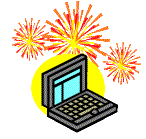Elements
of Design
Choosing Fonts
Fonts (type or typeface) are the
characters of a single design, all the letters in the alphabet, upper and lower
case, numerals, and symbols. Each
font belongs to a family whose design tie them together.
There are thousands to choose from but they fall mostly into three
categories—serif, sans serif, and script.
·
Serif
small finishing strokes on a letter
Example: T
·
Serif fonts are typically used for
text-heavy publications such as books and newspapers
·
Sans serif
no serifs (sans means without in French)
·
A bold sans serif font makes an arresting
headline
·
Sans serif subheadings in smaller sizes
create pleasing contrasts
·
Script
designed to make letters look connected, to imitate handwriting.
Fonts are also grouped by their impact or
function. Body fonts are for the
text of documents. They are
designed to be readable up close and for long stretches.
Impact fonts are designed to be striking and to be used for titles,
signs, and headings. Display fonts
are extroverts. They are designed
to amuse, surprise, or add pizzazz.
Designing with Fonts
Using fonts and white space can be very
effective in a publication. Think
about the old books you have seen with drop cap, fonts and the effect that the
style has on the reader.
·
Try to stick with two distinct fonts.
This establishes visual identify and minimizes confusion.
·
Mix fonts for contrast. This helps to organize your publication.
Maximum number of fonts 3.
·
Don’t mix two serif or sans serif
fonts. One from each category but
not two from the same category. Safe
rule—serif for the body and sans serif for the headings.
·
When in doubt, stay in the same font
family and create contrast by font size, spacing or level of heading.
·
Consider font color especially in web
pages.
·
Body text fonts
·
Body text between 10 and 12 is the norm.
·
Shorten lines to increase readability
·
Consider typographical measurement
·
1 inch = 72 points
·
1 inch = 6 picas (typographical
measurement)
·
72 points divided by 6 picas = 12 points
to 1 pica
·
Most art stores carry precision rulers.
By knowing how typeface measurement works you can check the look of your
electronic publication in the printer’s format.
·
Spacing between characters
·
Adjust (kerning) between individual
characters or between the characters in a section of text (tracking).
·
Adding space makes small fonts easier to
read
·
Decreasing makes text fit into a finite
space dictated by the publication size
·
Spacing between lines and paragraphs
·
Traditional look—indent the first line
of each paragraph.
·
Customary not to indent the first
paragraph after a heading
·
Contemporary look—put space between
paragraphs instead of indenting.
·
Aligning text
·
Should enhance the readability
·
Impact fonts
·
Titles, headings, headlines
·
Demand attention
·
If you must bread a headline, try to find
a natural break or balance the lines visually
·
Limit all caps—short headlines and
never in script!
·
Display fonts
·
Special text like drop caps
·
Use with care
·
Drop caps should be scattered on a page
not consistently used
·
For captions or callouts use a font that
is in the family of the body text or display font
·
For pull quote, use different font from
body text and make it at least six points larger—keep it short!
·
Sidebars should be near the text they
relate to in the article. Interesting
information that is related but a sidebar is not vital to understanding the text
of the article.
Graphics
·
How can a graphic help convey the message
of the publication?
·
How well does the graphic work in the
overall design?
·
Can a picture clarify the message?
Be careful about copyright
·
Attract the eye to support your
publication’s message.
·
Charts, graphs, and maps can simplify a
complex subject.
·
Captions—adds emphasis to the reason or
meaning of the graphic to your text
·
Complement the text with the graphic
·
Keep the caption short but convey your
point
·
In formal publications, place caption
consistently throughout the total document
Color
·
Can evoke emotions
·
Contributes to style and personality of
the publication
·
Establish as color scheme and stick to it
·
Monochromatic (variations of the same
color) scheme unifies
·
Complementary (opposites, green and red,
orange and blue) scheme grabs attention
·
Analogous (related colors, blue, green,
and yellow or yellow, orange and red) scheme produces harmonious look
·
Contrasting (dark and light, red, yellow
and blue or green, purple, and orange) scheme creates balance
Source
Microsoft
Publisher 98 Companion.
Microsoft Corporation. 1998.
|  Fly
Fly